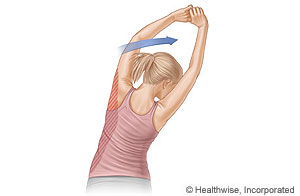
What is physical activity?
Being physically active means doing any kind of activity that gets your body moving.
The types of physical activity that can help you get fit and stay healthy include:
- Aerobic or "cardio" activities. They make your heart beat faster and make you breathe harder. Examples include brisk walking, riding a bike, and running. They strengthen your heart and lungs and build up your endurance.
- Strength-training activities. They make your muscles work against, or "resist," something. Some examples are lifting weights and doing push-ups. These activities help tone and strengthen your muscles.
- Bone-strengthening activities. They help encourage bone growth and strength. Examples include anything that uses your body to work against gravity, like running, jumping rope, playing hopscotch, and playing basketball.
Stretching can also play an important part in your activity. It can help you be more flexible and move your joints and muscles through their full range of motion.
What are the benefits of being active?
Being active is one of the best things you can do to get fit and stay healthy. It helps you to:
- Feel stronger and have more energy to do all the things you like to do.
- Focus better at school and perform better in sports.
- Feel, think, and sleep better.
- Reach and stay at a healthy weight.
- Lose fat and build lean muscle.
- Lower your risk for serious health problems.
- Keep your bones, muscles, and joints strong.
Being fit lets you do more physical activity. And it lets you work out harder without as much effort.
How can you make being active part of your life?
A good long-term goal is to be active for at least 1 hour every day. This may sound like a lot, but it's okay to be active in smaller blocks of time that add up to 1 hour.
Pick activities that you like—ones that make your heart beat faster, your muscles and bones stronger, and your muscles and joints more flexible. If you find more than one thing you like doing, do them all. You don't have to do the same thing every day.
Get your heart pumping every day. Any activity that makes your heart beat faster and keeps it at that rate for a while counts.
Here are some great ways to get your heart beating faster:
- Go for a brisk walk, run, or bike ride.
- Go for a hike or swim.
- Go rollerblading.
- Play a game of touch football, basketball, or soccer.
- Dance or jump rope.
- Play tennis or racquetball.
- Climb stairs.
Even some household chores can be aerobic—just do them at a faster pace. Vacuuming, raking or mowing the lawn, sweeping the garage, and washing and waxing the car all can help get your heart rate up.
Strengthen your muscles a few times a week. There are lots of options to tone or build your muscles. You can lift weights, do resistance activities that make your muscles work against (or "resist") something, or do a mix of both.
For example, you can:
- Lift weights or use stretch bands at home or a gym or community center.
- Do push-ups or sit-ups, which use your own body weight as resistance.
Participate in activities that strengthen your bones a few times a week. Weight-bearing activities put a force on your bones through impact. They help your bones grow and get stronger.
Some examples of activities that can strengthen your bones are:
- Walking and running.
- Jumping.
- Dancing.
- Sports where you jump or change direction quickly like tennis or basketball.
Stretch your muscles to increase flexibility. Stretching can help you loosen tight muscles and move your joints and muscles through their full range of motion. It can also be a great way to relax.
Before you start any activity, talk to a coach, physical education teacher, sports trainer, or parent. They'll show you the right technique to make sure you are safe. And they can help you make a program that meets your goals.
Where can you learn more?
Go to http://www.healthwise.net/patientEd
Enter S944 in the search box to learn more about "Learning About Physical Activity for Teens".
Current as of: June 5, 2023
Author: Healthwise Staff
Clinical Review Board
All Healthwise education is reviewed by a team that includes physicians, nurses, advanced practitioners, registered dieticians, and other healthcare professionals.

